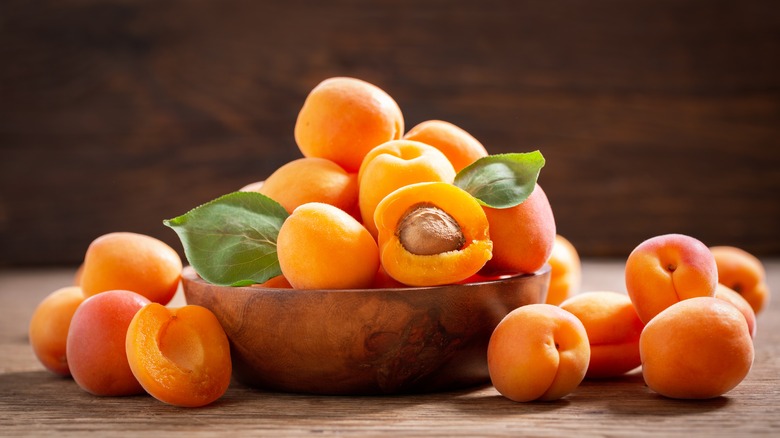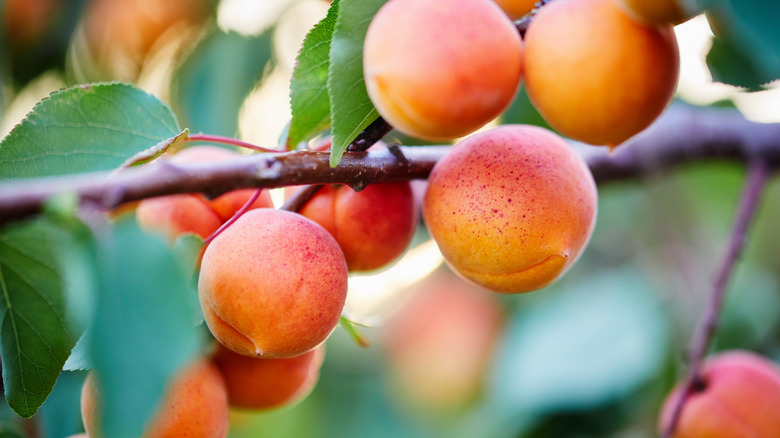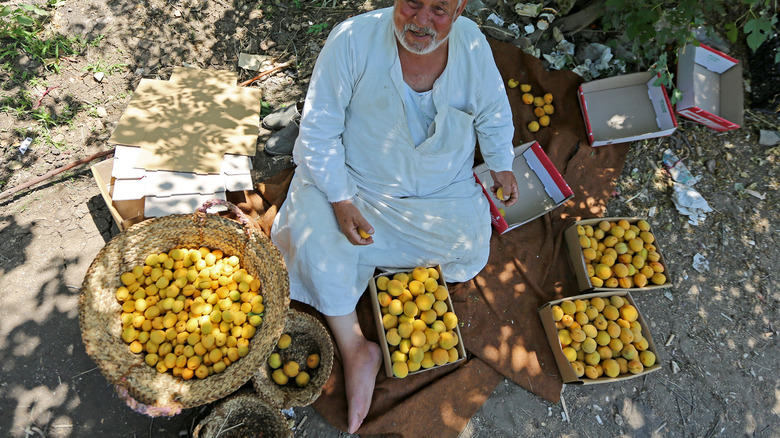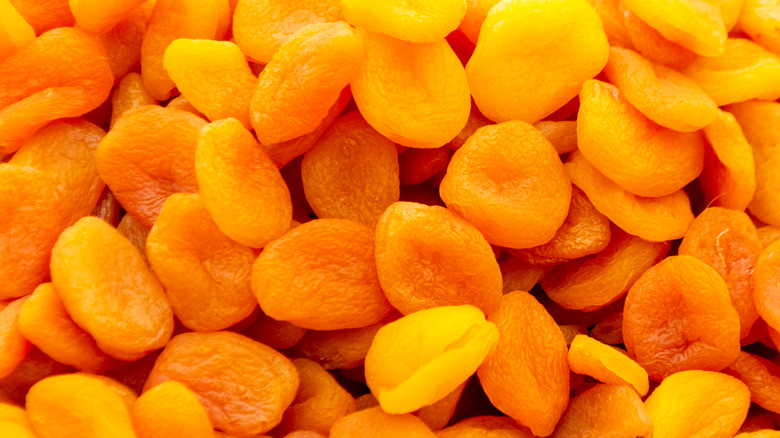Most Of The World's Apricots Come From This Country
Some occasions call for dried fruit to decorate charcuterie boards, while others require fresh fruit to dip into chocolate fountains or to squeeze into a refreshing juice. Thanks to advancements in agricultural science, fruits are available year-round, whether you need them dried for a fruitcake or fresh for a summer salad, and one of the best fruits to enjoy either way is the apricot.
It's not as common as strawberries or watermelon in the western world, but apricots are just as delicious and sweet. Food Network describes their flavor as peachy, but with a soft sour note that will make you salivate. The fruit is eaten both fresh and dried and makes for some excellent snacks, however, like other stone fruits such as peaches and cherries, it can also be baked into some incredible tarts and cakes. Apricots are related to peaches and cherries as well as almonds and prunes and are also known for being turned into jams and syrups for apricot cocktails (via Britannica). The apricot is not only wonderful in flavor, but is also beautiful in color with a bright gold and orange sink and flesh reminiscent of a sunset.
Turkey is a major apricot producer
Apricot trees are planted all over the world, but to date, Turkey is the world's largest apricot producer according to the Food and Agriculture Organization. A grower of many warm-weather fruits, Turkey is also the leading producer of figs and cherries due to its warm climate. Visit Local Turkey says that the apricot has had its roots in Turkey for thousands of years and thrives to this day under the careful hands of Turkish farmers. Apricots are heavily grown in several regions of Turkey, but while most of these regions produce fresh fruit, Malatya-Elazığ-Erzincan is well renowned for producing 85 to 90% of the world's dried apricots (via Golden Maprix).
Turkish apricots are notably different from apricots grown in California. Cooks Illustrated says that Turkish or "Mediterranean" apricots are dried whole whereas Californian fruits are dried after being cut in half. This makes them taste plumper and moister than the American variety which tends to exhibit more of the apricot's tart characteristics. So, if you are looking for a sweeter variety to use in recipes, turn your attention towards Turkish apricots and save the Californian-grown fruit for snacks.
The history of the apricot
Though apricots are now widely grown in Turkey and other parts of the Mediterranean, they did not originate there. According to National Public Radio, the fruit was first cultivated in China around 2000 B.C. The apricot eventually made its way west thanks to various efforts including those of Alexander the Great, the Silk Road, and immigrants who all found the apricot's unique sweetness too alluring to live in distant lands. The more the apricot spread, the more it became common to find it gracing the tables of royals and aristocrats as a sign of wealth.
Eventually, during the Persian wars, the tree was successfully planted in Southern Europe and eventually even made its way to England, France, and finally the Americas (via Academic Journals). Despite the tree's long journey across the globe, the apricot only really thrives in warm climates and becomes temperamental when it comes in contact with the cold. Cloud Mountain Farm Center says that apricots prefer to ripen during short dry springs, and low temperatures have been known to destroy an otherwise perfect crop.
The nature of an apricot
Today, apricots are more successfully grown in the East than in the West, but that doesn't mean that the fruit is not enjoyed by the masses (via World Atlas). Recipes such as apricot-cardamom preserves to serve along with tea and breakfast as well as dried stuffed apricots with walnuts for an appetizer or snack are enjoyed thoroughly. The apricot's sweet acidity as well as its recognizable color makes it a beautiful addition to the dining table
Apricots are also simply good for you to eat! Healthline says that regularly eating apricots may boost the health of your eye, skin, and gut thanks to their antioxidant, fiber, vitamin, and potassium content and the fact that eating fresh apricots is hydrating. The Fruits of Turkey reminds us that apricots are meant to be served and eaten both fresh and dried, but sun-dried apricots are especially well beloved as snacks and are easier to transport around the world than their fresh counterparts. You may note while shopping that some dried apricots maintain their bright orange color better than others, but don't be concerned if your apricots look brown. Naturally, dried apricots will lose their color and turn dark whereas sulfured apricots will maintain their hue.



